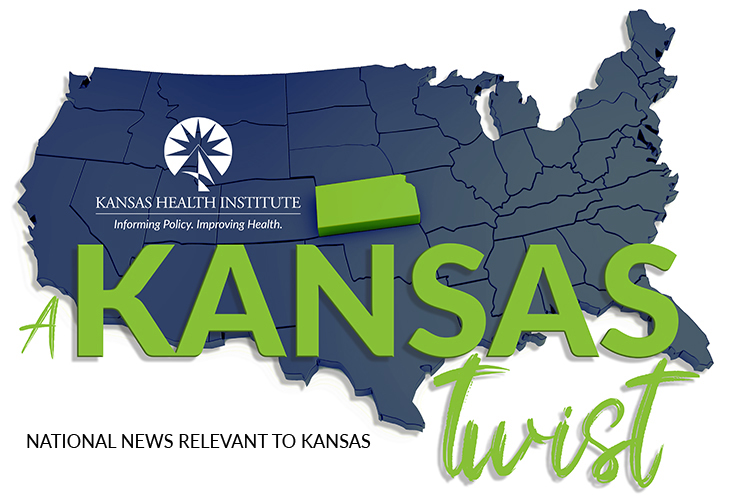As Kansans tried to beat the heat this summer, the state was experiencing a surge of COVID-19 cases due to the highly contagious Omicron variant. The KDHE COVID-19 Dashboard reported around 1,000 new cases per day in mid-July. On July 18, there were 1,577 new cases statewide – the first time that new cases topped 1,500 in a single day since February 7. While the number of new cases per day has decreased since mid-July, 89 of 105 Kansas counties had a high weekly new case rate of COVID-19 between August 13 and 19. Adult COVID-19 hospitalizations also have ticked up in recent months.
Sign up here to receive these summaries and more, and also follow KHI on Facebook, Twitter and LinkedIn. Previous editions of A Kansas Twist can be found on our ARCHIVE PAGE.
According to the Centers for Disease Control and Prevention (CDC), the Omicron variant spreads more easily than the original SARS-CoV-2 virus and the Delta variant. The circulating BA.4 and BA.5 Omicron subvariants may be even more transmissible than earlier subvariants. However, the growing use of at-home COVID-19 tests likely has led to an undercount of COVID-19 cases in Kansas and across the country. Health experts also are trying to determine whether Omicron is more likely to cause severe disease when compared to Delta and earlier variants, but preliminary data on hospitalizations and deaths show that Omicron has been less severe. However, the CDC has also stated that the severity of symptoms can be affected by vaccination status, history of prior infection, age and other health conditions.
For two years, KHI collected information on state and county-level decision-making around mask mandates and other communitywide protective measures aimed at mitigating the spread of COVID-19. As of August 22, there are no local restrictions in place in any Kansas county. With the changing nature of the virus, the CDC recommends the following tools to fight Omicron: COVID-19 vaccine, well-fitting masks, testing and treatments.
The evidence appears to indicate that vaccines are an effective tool against severe COVID-19 illness. The COVID-19 vaccine is currently available for everyone six months of age and older for at least the primary series – one or two doses depending on the vaccine manufacturer – and, for many, at least one booster dose. Those who are moderately or severely immunocompromised are eligible for additional booster doses. Persons recently infected are advised to consider delaying vaccination by three months from symptom onset or positive test. However, experts suggest that the BA.4 and BA.5 subvariants may be able to evade some of the antibodies produced after vaccinations and infections, including those caused by earlier Omicron subvariants. In response, vaccine manufacturers have been developing a variant-specific (i.e., bivalent) vaccine booster.
On August 16, the CDC released a fall vaccination planning guide, and the Biden administration has secured 175 million bivalent COVID-19 vaccine booster doses for distribution in the fall and winter of 2022. A single booster will be administered to those who have previously completed at minimum the primary series. Age eligibility is anticipated to be age 12 and older for Pfizer vaccine and 18 and older for Moderna vaccine.
With children returning to school, school districts across the state may be considering whether mitigation measures are needed in the fall and winter. On August 11, the CDC updated its COVID-19 guidance for schools and childcare settings. In this update, the agency’s recommendations offer flexibility for schools and communities to adopt measures that best fit their needs and be nimble and able to adapt to changing situations (i.e., surges).
For schools and childcare settings, the CDC recommends staying up to date with COVID-19 vaccinations, staying home when sick (and testing as soon as possible after symptoms begin), optimizing ventilation, maintaining improvements to indoor air quality, reinforcing proper hand hygiene and respiratory etiquette, and cleaning surfaces at least once a day. The CDC removed the following strategies:
-
- Cohorting, referring to when children are kept in small groups throughout an entire day.
- Conducting weekly screening tests; however, when COVID-19 Community Level is high or in response to an outbreak, screening would resume.
- Test-to-stay, which allowed students who were exposed at school and were not fully vaccinated to attend school by testing daily.
- Quarantining, except for in high-risk congregate settings.
For communities, the CDC has simplified measures for those exposed and those infected with the following modifications:
-
- No longer screening asymptomatic people with no known exposures.
- In lieu of quarantining, those exposed should wear a high-quality mask and watch for symptoms for 10 days, and get tested on day 6. The guidance defines day 0 as the day of last exposure and day 1 is first full day after the last exposure.
- For those with mild illness from COVID-19, isolation for at least five days, regardless of vaccination status. After isolating, people who are recovering should avoid contact with vulnerable people for 11 days. Isolation may end after day 5 if symptoms are improving and the individual is fever free for 24 hours without the use of fever-reducing medication.
- For those with moderate illness (e.g., experiencing shortness of breath or difficulty breathing), isolation through day 10.
- For those with severe illness (i.e., hospitalized) or those with a weakened immune system, isolation through day 10 and consultation with physician before ending isolation.
Check back for more information as we continue to monitor response to the COVID-19 pandemic.
